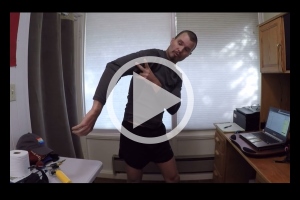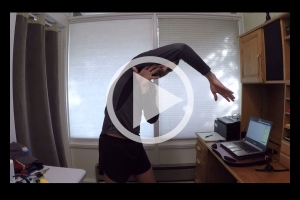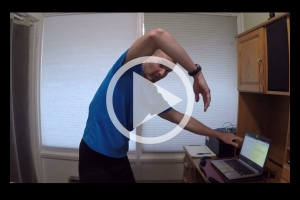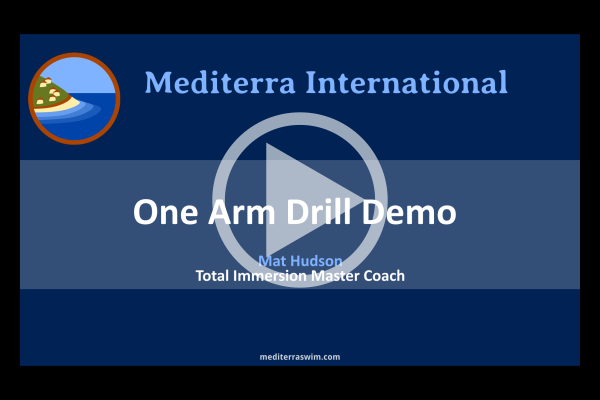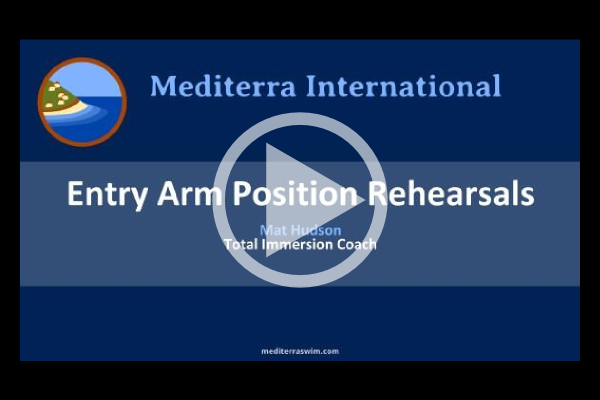by Admin Mediterra | Sep 25, 2020 | Fundamental Skills
The entry and extension into streamline is how you deliver force into forward motion. The hand enters at a certain location, near the head, in front of the shoulder. It drives down into the water steeply, like traveling down the start of an Olympic ski jump. Then the arm begins to extend underwater, and its path levels out as it reaches target depth, straight in front of that shoulder. Then the arm continues to extend and reach, piercing the target, which brings your body into its best Streamline Position. Your body is lengthening and becoming more streamline with each microsecond. In this way, you receive the three forces from the recovery arm momentum, from gravity, and from the catch and convert all that into acceleration.
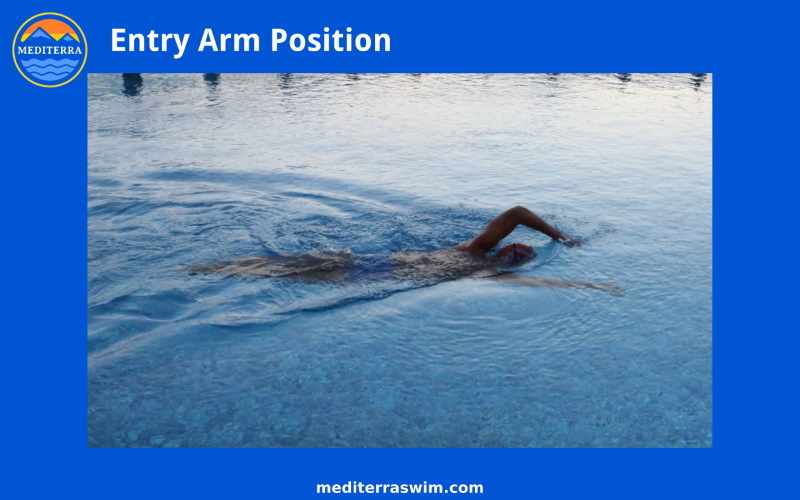
Below is an outline for how we form the entry and extension, and you will find some additional focal points and diagrams on the 101 Cues for Freestyle page under the Entry And Extension section.
The entry has a certain timing, a particular pathway and a certain smooth speed to make it most effective. The better your Entry and Extension into your best Streamline Position, the more that force is transferred into forward motion.
Let us reiterate this again so that it sinks in: The whole emphasis of the stroke is to Send Force Forward through the Recovery + Entry + Extension into Streamline. Everything else, including the catch, supports this primary action of sending the vessel of your body forward. This is the finish of the freestyle stroke. Treat this section of the stroke cycle as the important moment everything else has been preparing for.
Instructions
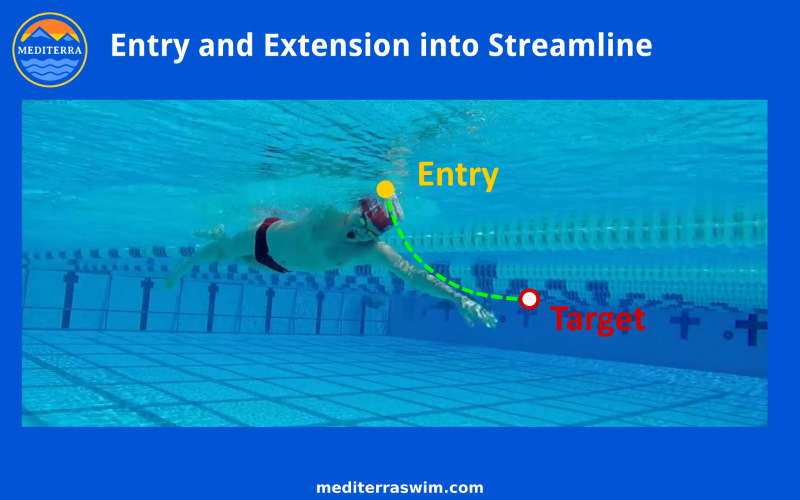
The forearm begins to enter close to the head, in front of the shoulder, with a steep angle, as if driving downward… at first. You are only going to start at a steep angle, but it will not stay this way.
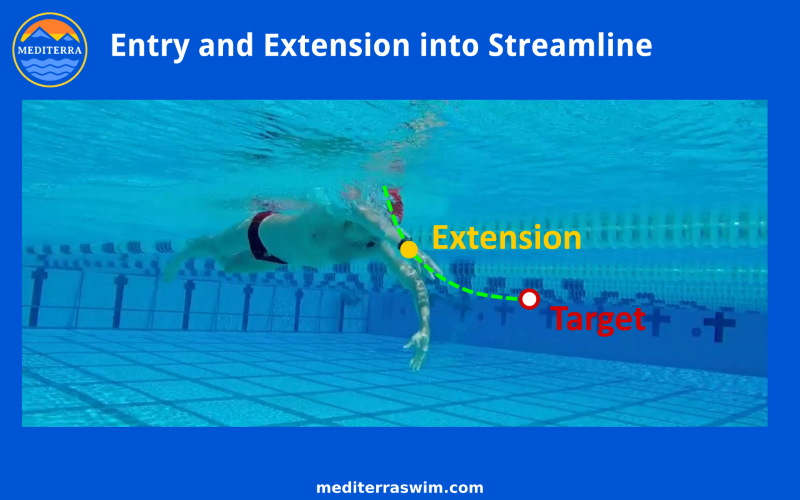
Remember, the goal is to Send Force Forward, the arm must be underwater as it extends toward the target. This requires an early entry position and a steep entry angle so that the arm can harness the rotational force of the torso into parting water molecules in front of the body.
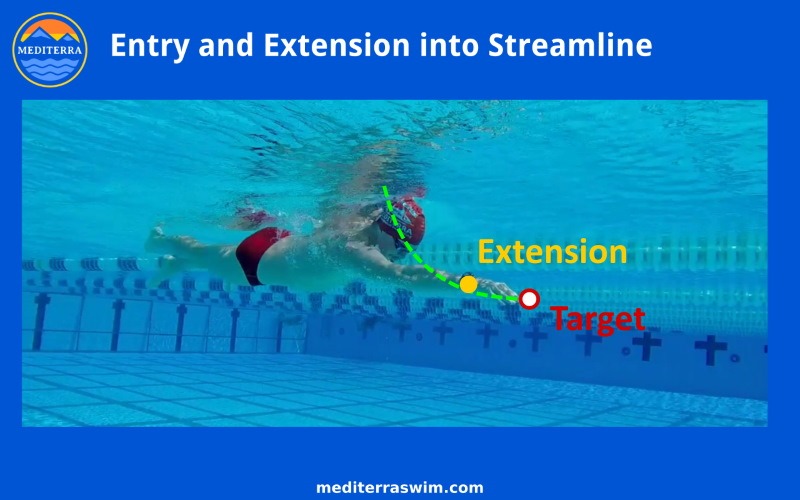
The arm drives down, on a curving path, to target depth and then levels out as it aims to pierce the target. The hand should come to a depth just below the lowest point of the body line. Notice that the emphasis of the lead arm is to stretch forward, not downward.
Notice how long and straight the body is on the streamline side. The swimmer is fully extended and continuing to emphasize the reach. He is not ‘twisting’ into an over-rotated position in order to reach. The side of the body is lengthening, as if he was going to pierce the target with his wrist.
Drills Useful For Entry Practice
- Standing rehearsal to create entry arm shape
- Recovery Swing, One Arm (swing to Entry Position and dip it a few times)
- 1-Arm Slot To Streamline (standing, with one arm in entry position, fall forward into Skate)
- 2- Arm Slot To Streamline (standing, with one arm in entry position, and one arm in Streamline Position, fall forward and switch arms, slide into Streamline)
Cues for Entry
- Elbow high above ear
- Elbow swings forward as far as comfortable
- Feel the stretch in the back as you reach entry position
- Forearm aiming straight ahead on track
- Forearm angling down (45 degree, like ski jump)
- Hand entry position across from opposite (lead arm) elbow)
Cues for Extension Pathway
- ‘Ski jump’ shape entry path
- Slide down to target depth and forward
- Spear wrist through your target
by Admin Mediterra | Sep 24, 2020 | Synchronization
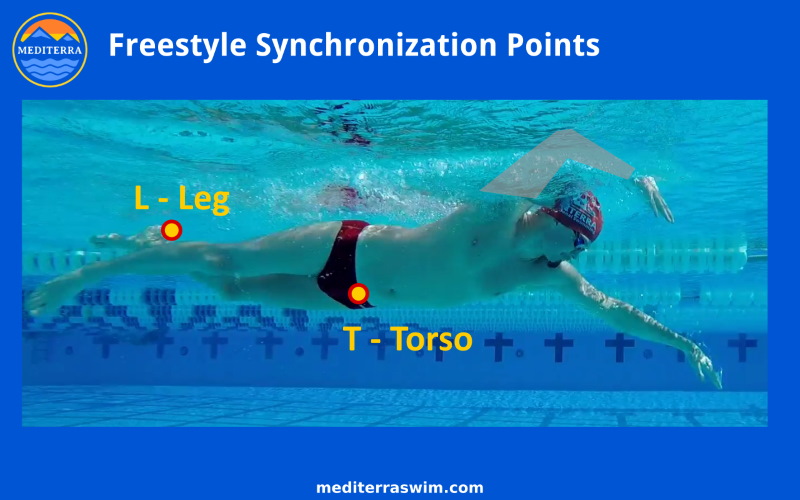
Once you have practiced the LT (leg-torso) synchronization, and the ET (entry-torso) synchronization, then it is just a blending of both of those to create the LE synchronization. However, this is moving across the body, from one extreme end to the other. It can be the most difficult connection to make, but once you do, it is the most pleasing one!
Once again, you are ‘zooming out’ to take in the full body, from foot on one side to wrist on the other, to feel the connection between these two actions, through the torso. The torso rotation empowers the entry and extension to the target. The press of the leg supports the torso rotation. Therefore, the press of the leg helps empower the extension forward.
This is often the last sync combination to practice because the other synchronization combinations are set up to support this main action of extending farther forward on each stroke. This LE synchronization is what will make your stroke as long as it can be optimally. It is what creates the acceleration you seek on every stroke. So, take the time to establish the other connections, and they will enhance this one.
Instructions
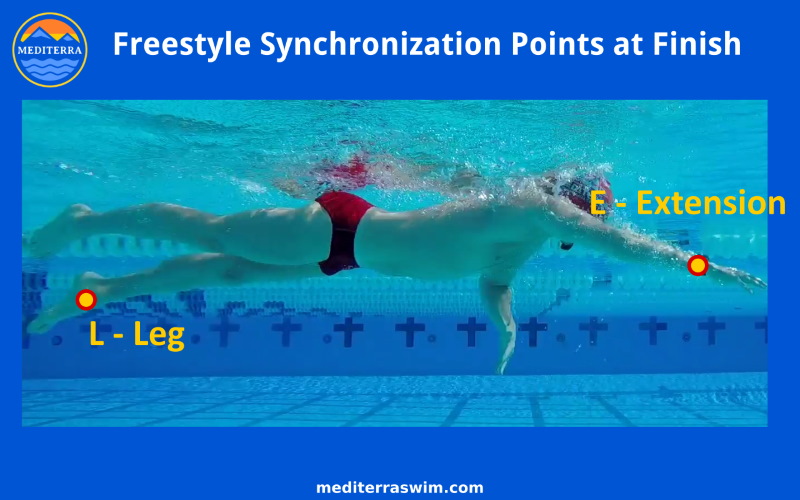
When the leg comes down to its finish position the entry arm is sliding into streamline position.
Just as you practiced pressing the leg more slowly, with a steady pressure to match the torso rotation, aim to match the pressure and rate of speed of the extension also. As noted previously, it is tempting to ‘snap’ the foot for an abrupt kick, but this sends a wave of force too quickly forward, before the extending arm is ready to absorb and apply it to extend further. Keep the press of the leg as steady and smooth, matched to the torso rotation, and thereby matched to the entry/extension. The more closely these two are matched and kept proportional in speed, the more the press of the leg can assist that extension, the more you can feel it assisting. The leg will move faster and get to its finish position before the extension finishes, but aim to make that press last longer.
There is some room to adjust the timing of the press to the tempo. At slower tempos, have the press of the leg come about half way into the entry, with the intent to use the press to help finish the extension to the target. At very fast (sprinting) tempos, it may be more helpful to have the press of the leg come right as the hand is entering in order to drive it more powerfully and more quickly to the target, since the fast tempo allows so little time to get there through the water resistance ahead.
Remember to keep all actions smooth no matter how much force is involved. You can be powerful, but in water, power must be applied smoothly, gradually building up, in order to create a more uniform (less turbulent) displacement of water molecules. Smooth actions keep drag to a minimum. As Coach Mat says sometimes, “Make the action like you are cutting butter, not like pounding meat.”
And, when you are feeling fatigued, or still have a long way to swim, this can be one of the more endurance-promoting focal points you can use. The default land-mammal reaction to fatigue is to start pulling back harder on the water. Resist this urge. Instead, put your dwindling resources into protecting this Send-Force-Forward emphasis in your stroke. Under fatigue, it will do more to reduce your loss of speed and extend your energy than just about any other emphasis.
by Admin Mediterra | Sep 24, 2020 | Synchronization
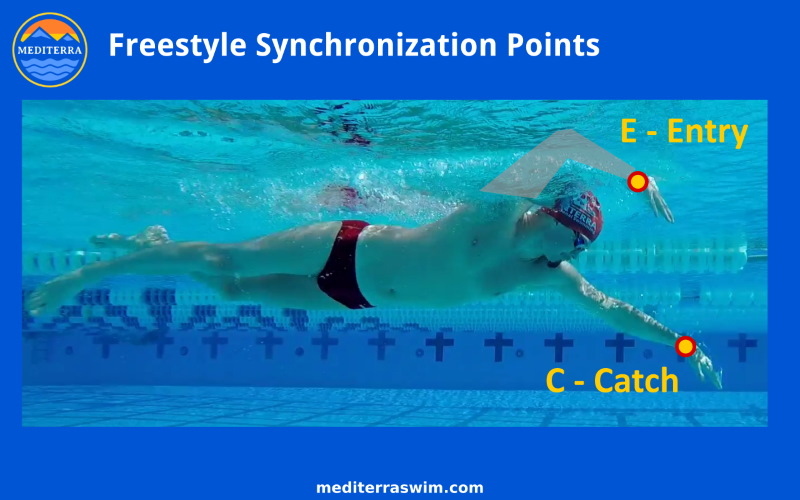
There is an ideal timing for the switch of the arms in front of the body. In the image above you can see the entry hand (E) piercing the water just across from the elbow of the lead arm. This is about the ideal moment for the arms to switch positions. Now the lead arm can begin the catch (C).
Just before this moment, the lead arm continues to extend forward while waiting for the recovery arm to come fully forward. Note that the lead arm is not passively hanging there – that side of the body is actively stretching the whole time. The streamline side of the body feels long and firm and getting longer.
There is some small room for adjustment depending on the tempo, but in general the ideal timing is to have the catch begin at the moment the entry hand has entered the water. For slower tempos your entry arm might be submerged to past the watch band by the time you set the catch, and for faster tempos your fingers may just start to pierce the water at the time you set the catch. But to switch earlier than this, or later than this is going to introduce greater ‘power leaks into your stroke.
Another way to phrase this is ‘arm overlap’. Notice how far the entry arm overlaps the lead arm in about the ideal amount. If you have too little overlap, or too much overlap at the moment the arms switch, then the catch is not able to connect with the full torso rotation, and ‘power leaks’ from the propulsive action. When there is just the right amount of overlap, then you are able to transfer force from the catch side to the entry side of the body instantaneously, and smoothly. Timing both sides with the full torso rotation is the key.
At the moment your entry hand is piercing the water, your torso begins to rotate. The ideal is to connect the catch to the start of this torso rotation also. Notice how all three must happen together.
Imagine a steel cable tying the catch wrist to the entry wrist. This cable passed through the shoulders. When one wrist moves the other must move in immediate response to it, in one smooth motion. The shoulder connect the two arms. When you set the catch on one side and start to press against the water, you instantly transfer that force – through that imaginary steel cable – into the entry arm. The entry arm slides down and then extends forward, receiving the force from the catch side of the body. This is how you generate and feel acceleration on each stroke. This is where the magic begins.
Instructions
First, in slower motion strokes, establish the ideal timing, or ‘overlap’ position and get very familiar with this.
To make the ideal zone more distinct in your nervous system, occasionally try too much overlap, and too little overlap in order to feel how those distortions cause your stroke to feel less connected, less effective. Notice how you get less acceleration.
Gradually speed up the tempo while maintaining this same ideal overlap. Eventually, you should be able to keep proper switch timing at every tempo you train with, from slow to sprint tempos.
Remember that the motion of the two arms, entry and catch sides, through the shoulders, should feel firmly connected to each other. You are aiming for a immediate, smooth transfer of force from one side of the body to the other, that gives you a sense of acceleration on each stroke.
The better the catch shape and pathway, the more force you generate that is available to be transferred to the other side.
The better your streamline position, the farther your body is able to slide forward once it receives that force.
The better your arm switch timing (the amount of overlap), the more of that force is transferred to the other side.
by Admin Mediterra | Sep 24, 2020 | Synchronization

The Catch (C) and the Rotation (R) (sometimes represented by the Hip), are not often connected in the typical swimmer. This is where one of the biggest power leaks can be plugged.
Again, the rotation – with shoulders and hips tied together into one unit – may be represented by the hip.
Ideally, you will set the catch (initiate the start of the catch) at the moment the hip is beginning to turn. On the same side of the body, the hip will begin rotating upward, and the catch will begin pressing backward. But these can only happen together when the Entry is located and timed first. Remember that the rotation will always wait for the Entry. So if the catch must wait for the torso to turn, that means it must also wait for the Entry to start – then all three will happen together.
If E and C are synchronized first, then and only then can you work on the C and R synchronization. EC must be in place first.
The easiest way to isolate the connection of the Catch and the Rotation is to do a One-Arm Swimming Drill. This drill takes the other arm out of play, so as you move through the stroke cycle with only one arm, you will be forced to use rotation to empower the catch. It should make sense to your body to do it this way when you have only one arm, and it will be obvious how helpful it is to have the torso rotation create the main power of the catch. But the moment you put the other arm back into the choreography, you may notice that your catch no longer automatically connects to the rotation – often it will start pulling way before the torso starts turning! When the catch starts pulling before the rotation, this means that arm must pull with small shoulder muscles the whole way – the small shoulder muscles will tire so much more quickly than the torso muscles will!
You can test the timing of your EC arm switches by doing recovery and entry drills to make sure your entry hand reaches the entry position as the trigger for the catch to begin.
Instructions
The goal is empower most of the catch by the rotation. In other words, you want to shift more of the catch load to the torso (to the side and back of the body) and lighten the load on the smaller shoulder muscles. The sensation you are aiming for is to feel the pressure you apply coming from that side and back of your torso, where you do not feel acutely strained in any small muscles of the shoulder. It will feel easier to maintain a powerful hold on the water when you can hold with the whole side of your body.
Beware: Just because the catch and rotation are happening at the same time does not automatically mean that the loading has been shifted to the torso. You need to feel that you are holding mostly with the slide of the shoulder toward your hip – this will engage your lat muscles which you can feel easily. If you feel more loading in the small pulling muscles around the shoulder and little or no loading on the back and side of your torso, then you have not transferred enough of the load to the torso.
This is easier to notice and improve at slower tempos. Start slowly to tune up this pattern then gradually increase tempo to normal rates as the pattern gets familiar to your nervous system.
It may be helpful to imagine an elastic band connecting your (catch side) wrist to your hip. As the hip rotates upward, it pulls the wrist backward through this imaginary elastic band.
Keep the rate of the hip turn about the same as the rate the catch/hold is pulling back on the water. Do not pull abruptly on the water. Nor should you try to rotate abruptly. You can be powerful, but apply that power gradually, and smoothly.
These two moving parts of the body should feel instantaneously connected in the same unified action, on this side of the body.
Try disconnecting CR and count strokes, then connect CR and count strokes. You should notice a clear difference in SPL between the two.
by Admin Mediterra | Sep 23, 2020 | Tutorial Videos
An description of how to keep the emphasis of the stroke on sliding forward.
An description of how to keep the emphasis of the stroke on sliding forward.
by Admin Mediterra | Sep 23, 2020 | Tutorial Videos
An explanation for how to keep the elbow pointed in the right direction through the entire freestyle stroke cycle.
by Admin Mediterra | Sep 23, 2020 | Drill Demos
The one-arm drill is useful for a variety of skill projects and focal points, including recovery, entry extension, stability, 2-beat kick, and breathing timing.
by Admin Mediterra | Sep 23, 2020 | Drill Demos
Below is a demonstration of various rehearsals one can do to practice best entry arm position in freestyle…
A series of rehearsals to help you find a better entry arm position.









